Col. Warren E. Carey
Warren Earl Carey was my father's first cousin, the son of Rev. George Edward and Melissa (Waldron) Carey. He was a big man, measuring about 6'3" and weighing over 200 pounds. I always felt a special kinship and closeness to Warren, even though I didn't see him often, because my parents chose to honor him by giving me his name for my middle name. At an early age, I became interested in family history as a result of his influence. I have all of Warren Carey's research papers. They were the foundation and starting point for my own research into my Carey and Perry ancestry.
In this page, I'll present a brief sketch of Warren's life, followed by a collection of references to him which I've found in the Los Angeles Times and other public sources.
Warren was born 29 Jan 1896 in Urbana, Ohio, the first of George and Melissa's three children. As a small boy, he worked in his uncle Sam Carey's greenhouse and in 1907 was dismayed to hear of the arrival in this world of my father, fearing that the boy would soon put him out of a job. Warren became interested in aviation and, after World War I broke out, was commissioned a Second Lieutenant in the aviation section of the U. S. Army Signal Corps, later to become the Army Air Corps. He never flew in combat, although Huell Howser referred to him in a television documentary as a "World War I ace". Warren's World War I service record is summarized in ancestry.com's data base of Ohio Military Men, 1917-18:
Detachment AS Signal Enlisted Reserve Corps Chicago Ill to 10 May 1918;
School of Military Aeronautics OSU Columbus O to 24 Aug 1918;
Aviation Concentration Camp Cp Dick Tex to 29 Oct 1918;
Detachment Flying Cadets Eberts Field Ark to Discharge
[enlisted as] Private, first class 12 Jan 1918.
Honorable discharge 26 Nov 1918.
Warren's service number was 973077 and his address at time of enlistment was 210 Monroe St., Troy, Ohio. He enlisted at Cincinnati.
At the end of the Great War, Warren retained his commission in the reserves and became involved in a variety of "aviation pioneer" exploits. After growing up as a "preacher's kid" in western Ohio, he moved to California along with his family in about 1921. He worked from 1928 to 1938 for the Union Oil Company as a pilot and once flew from California to Guatemala to scout out airport sites for future air travel routes. The details of this part of his career are somewhat sketchy, but we'll add information when and if it becomes available.
Warren married Wilma Elizabeth Smith in Reno, Nevada, 30 Nov 1934. Wilma was born 29 Oct 1906 in Auburn, California, the daughter of Alfred Lovell and Nell (Breslin) Smith. At that time, marriages between Protestants and Catholics were not common and I can only wonder now at Warren's Methodist minister father's feelings. Warren and Wilma bought a house on Micheltorena Avenue in the Silver Lake district of Los Angeles. This house was either unfinished or else they decided to remodel it extensively, as I remember making several trips there with my parents and playing in the back yard while Dad helped Warren with carpentry work.
In 1938, Warren accepted a position with the Civil Aeronautics Administration on its Air Safety Board. He was also appointed to California's state airport advisory board, and was involved in the investigations of several aircraft accidents, including the crash of actress Carole Lombard's TWA flight near Las Vegas in January 1942.
Soon after this event, Major Warren Carey was recalled to active duty with the Army Air Force, which soon promoted him to Lieutenant Colonel and sent him to Winston-Salem, North Carolina. He and Wilma spent the rest of World War II there. Before his discharge, Warren was promoted to Colonel and was awarded the Legion of Merit for his work in implementing safety procedures in military aviation. He returned to Los Angeles shortly before his father's death 28 Nov 1945. I can remember him attending the funeral in his colonel's uniform.
In 1946, California governor Earl Warren appointed Warren Carey as "chief of the State master airport planning staff of the State Reconstruction and Re-employment Commission", as the position was described in the Times, then in 1947 to be California's first director of the State Aeronautics Commission. These duties caused Warren and Wilma to move to Sacramento, although they occasionally returned to southern California for visits. Warren resigned from his state post effective 1 Nov 1951.
After his return to Los Angeles, Warren bought the Elite Food Centre, on Sunset Blvd. near his home. I fear this wasn't a profitable or wise investment choice. Elite was a small store which offered to deliver groceries to its customers. This was the age of the supermarket and he seemed to have to work long hours in his small market to keep it going. Warren died of a heart attack at his home 20 Aug 1963, only a few days after I visited him at the store to introduce him to his cousin Dave's 19-month-old namesake.
Some time after Warren's death, Wilma moved to Parklabrea Towers in West Los Angeles, where she lived with her sister the rest of her life. She died 26 Feb 1985 and was buried in her birthplace, Auburn, California.
The Union Oil Aircraft
In May 2016, I received an e-mail from John D. Lyon which included the photograph below. John wondered:
Do you have this photograph? It appears to have been taken at Clover Field (Santa Monica Airport) in the very early 20s. The airplane is a Travel Air 2000, s/n 423.
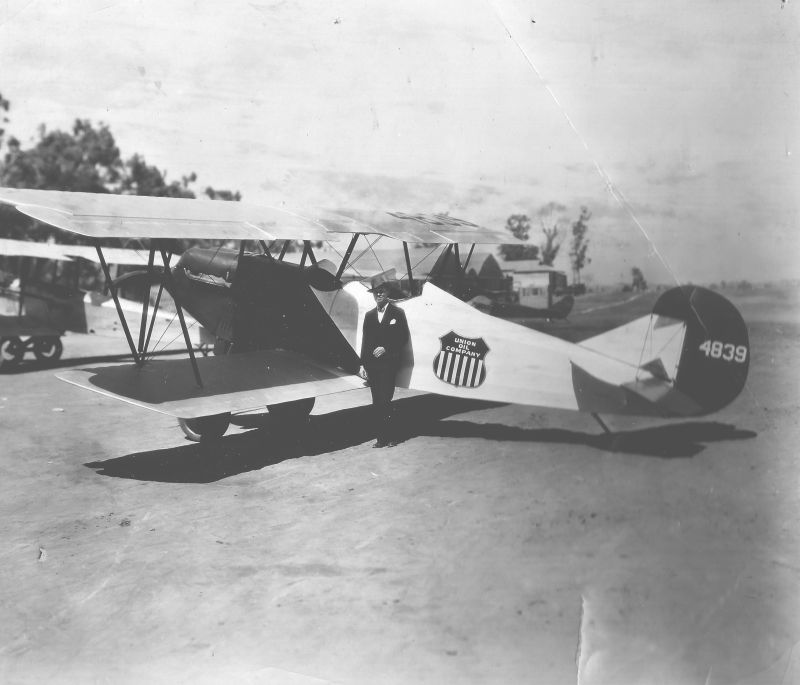
I am uncertain whether the gentleman is Col. Carey. It is possible that it is Charles F. Lienesch. I would welcome your opinion. Here is an internet reference with details on the airplane and its purchase by Union Oil. The CHARLES F. LIENESCH Page of the Grand Central Air Terminal Register Web Site.
Here is a reference to Col. Carey's flying this particular airplane: The REGISTER DETAIL Page of the CLOVER FIELD REGISTER Web Site.
No, I must confess that I don't have this particular photograph, but I know I've seen photos of Warren with a similar Union Oil aircraft. Even when this picture is blown up to its full size, I'm unable to tell if that's Warren, or somebody else. I'm keeping it here on Warren's page, though, so you can see the kind of work Warren did in the Twenties. And thank you, John, for your interest in our site, and for sending us this great photo!
In response to my thank-you note, John wrote back:
You're welcome, Chuck. There is also a 1934 photo of Col. Carey and the other members of the Los Angeles County Sheriff's Aero Squadron.
I am the historian of the Los Angeles Hangar of the Quiet Birdmen, and your work makes mine a lot easier. Thanks.
Warren Carey's careers in aviation and government frequently caught the attention of the Los Angeles Times and other newspapers. He is mentioned in numerous articles over a forty year span which provide some good insights into the history of aviation and the thinking of the day, as well as into the career of this Carey cousin.
The earliest mention of his name that I could find is in an article in the 7 Jun 1925 Times describing the journey of a group of local aviators to Sacramento to participate in an "air meet". Most of the article consists of the description of an auto accident some of the birdmen had on the way, but it concludes:
... This thrilling dash to Sacramento was followed the next day by the local aviators going up into the sky in borrowed planes and walking off with a cup emblematic of their skill in keeping in perfect formation.
I was able to pick out "W. E. Carey" immediately, without looking at the caption, in this photo which accomanied the article. He's third from the left in the back row:
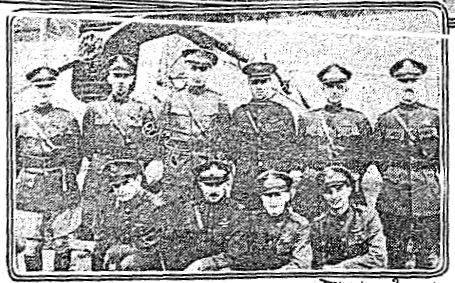
A 2 Aug 1925 Times article mentions Lieut. W. E. Carey among some sixty officers of the 322nd Air Service reserve pursuit group, based at Clover Field, Santa Monica, who were reporting to Rockwell Field, in Coronado, to attend a two week summer training camp conducted by Regular Army officers. The trainees were to fly JN4B and DH aircraft.
Soon after his going to work for Union Oil, Warren's name pops up in this 20 Oct 1928 Times article:
UNION AIR FLEET TO SANTA MARIA AIRPORT
SANTA MARIA, Oct. 19 -- Three airplanes of the Union Oil Company's aerial fleet will fly from Los Angeles tomorrow morning to participate in the dedication of Hancock Field, Santa Maria's new airport. The ships will be flown here by Roy Harding, W. E. Carey and Edwin C. Moore, veteran pilots and members of the Union's aviation division. Visiting airmen from many airports in Southern California are expected to attend and participate in the eight big events which carry with them prizes totaling $2000.
Page G10 of the 28 Oct Times is full of aviation news, including a lengthy report of the Santa Maria event. The enthusiasm of that period is illustrated by the beginning of the article, which includes only a brief mention of W. E. Carey's participation:
The air consciousness of the American public was forcibly demonstrated at the formal dedication of the Santa Maria airport last Sunday, when it is estimated that over 25,000 people attended the opening ceremonies...
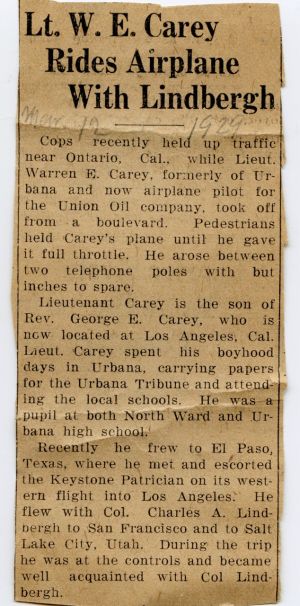
This article in the 3 Feb 1929 News of Southern Counties section of the Times described an event which must have caught a lot of people's attention:
AVIATOR USES ROAD FOR PLANE RUNWAY
ONTARIO, Feb. 2 -- It isn't often that a California Boulevard is used as a take-off field for airplanes, but when Lieut. W. E. Carey, Union Oil Company aviation representative, took off from Ontario airport today for Los Angeles he carried with him the knowledge that he has accomplished what few other pilots have.
Previous to the parade and pageant at the unveiling of the "Madonna of the Trail" statue in Upland yesterday, Lieut. Carey flew a plane here for entry in the parade. He landed on one of the fairways at Redhill Country Club and the plane was towed toward Upland.
Near Upland there wasn't room enough between telephone poles to get the ship through on Foothill Boulevard.
Rather than tow the ship back to Redhill, Lieut. Carey recruited a number of bystanders who helped turn the ship around.
A traffic officer stopped traffic near the Sycamores Hotel. The bystanders held the plane while Lieut. Carey opened his engine wide. Then with full power on the plane raced along the crown of Foothill Boulevard, leaped over culvert guards and took to the air safely. Because of low clouds and rain the plane was parked at Ontario airport until today.
A 19 Feb Times article reports that Warren piloted, in a Union Oil aircraft, two representatives of the Los Angeles Junior Chamber of Commerce to San Francisco "to meet with the junior chamber of that city to work out a program for establishing air markers between Los Angeles and San Francisco..."
The Times' 19 Mar 1929 article describes the whirlwind visit of Charles Lindbergh to Long Beach and Los Angeles. This was only two years after Lindy had captured the nation's attention with his solo flight across the Atlantic. During his visit, he was honored at a luncheon at the Ambassador Hotel. Among the guests were "W. E. Carey, Southern California aviation representative of the Union Oil Company". Lindy's visit and his encounter with Warren were also described in an Urbana newspaper. Cousin Tim Hennessey sent us the clipping on the right which he discovered in his family history archives. It also tells the story of Warren's impromptu takeoff from Foothill Blvd.
An 29 Oct 1930 Times article lists W. E. Carey among the pilots departing Burbank on this tour:
AIR CARAVAN HOPS TODAY
Chamber's Good-Will Flyers Off on Five-Day Tour of State Traveling in Forty Planes
With five days of flying, banquets and addresses ahead of them pilots and passengers in forty airplanes of various types are scheduled to leave from United Airport, Burbank, at 8:15 a.m. today on the second annual California Good-Will Air Tour.
Pilots of the ships, ranging from giant trimotored cabin transports, to single-seat sport craft, will meet at the port for an instruction breakfast at 7:15 a.m...
A 31 Jan 1932 Times article reports the acquisition by Union of two new Curtis-Wright Travelair biplanes capable of cruising at 145 miles per hour, with a top speed of 165 mph. Warren was one of the pilots who took delivery on the planes in St. Louis and flew them to the West coast.
An article in the Times for 30 May 1932 described Warren as the Operations Manager of the "Olympic air tour" which was apparently going north from somewhere in CA to Seattle. Several of the aircraft, referred to as "ships", were blown off course and forced to land at various small airports. A 13 Jul 1932 article reported:
PURSUIT SQUADRON ORDERED TO DUTY
Ninth Corps Area headquarters in a dispatch from San Francisco yesterday announced the Four Hundred and Seventy-ninth Pursuit Squadron, composed of Air Corps Reserve officers residing in Southern California, has been ordered to temporary active duty for two weeks beginning next Sunday at the Municipal Airport, Long Beach...
Among the seven officers mentioned was Capt. Warren E. Carey. This call-up was apparently a routine exercise, rather than a response to any kind of emergency. The following appeared in Terrel DeLapp's 12 Feb 1933 Skyways column:
Planes Not to Blame
That air-mail letters in some instances are not reaching their destinations as swiftly as possible was the opinion at the meeting of the southern aeronautical committee, California State Chamber of Commerce.
Result was that R. Randall Irwin and Warren Carey were appointed to confer with postmasters in this district to determine the cause.
Discussion at the meeting indicated that planes get mail from point to point on time and that possible delays occur in postoffice routing.
A 29 Apr 1933 article mentioned an announcement by Los Angeles county sheriff Eugene Biscailuz of personnel making up the "recently formed Sheriff's Aero Squadron which is intended to function in the event of a major disaster. Among the "business and professional men and military flyers of the county" who were recruited was Warren E. Carey. A 3 Jan 1934 article about the Aero squadron listed some of its members who included, besides Warren, actor Hoot Gibson and future aircraft manufacturing mogul Howard Hughes.
22 Mar 1935, Warren's involvement in Sheriff's aero squadron is again mentioned in the Times' San Joaquin valley section. Warren, as "Union Oil Company official and volunteer executive officer", is visiting Bakersfield to arrange for the squadron's arrival on its goodwill tour.
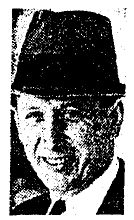 The picture of W. E. Carey on the left appeared in a 7 Apr 1935 article which described in detail a new Stinson Reliant cabin monoplane acquired by Union. (See photo of aircraft below.) The article concluded:
The picture of W. E. Carey on the left appeared in a 7 Apr 1935 article which described in detail a new Stinson Reliant cabin monoplane acquired by Union. (See photo of aircraft below.) The article concluded:
W. E. Carey, popular Union Oil Company pilot, who is known the length of the Pacific Coast among aviation enthusiasts, took delivery of the ship last month at the factory at Wayne, Mich.
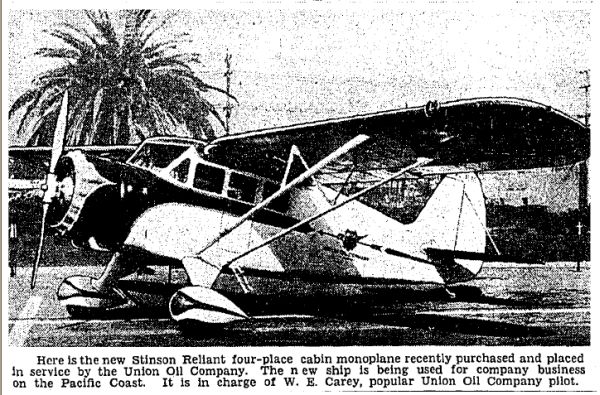
In several Aug 1935 and Aug 1936 Times, Warren was mentioned as the "general chairman" of the Los Angeles-to-Cleveland "Ruth Chatterton continental air derby". The following photo appeared 26 August 1935:
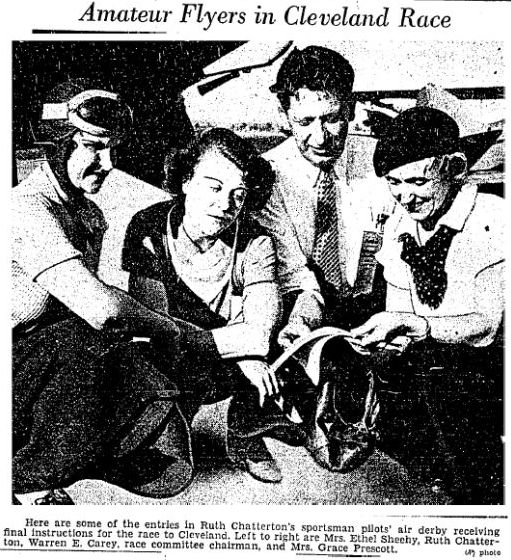
In the 19 Jan 1936, Warren is reported to be attending a meeting of a group of flyers who founded an organization tentatively named "Sport Wings". The 12 Mar 1936 issue lists him as a director of the Aviation Country Club of California, Inc.
23 and 30 August 1936, Capt. and Mrs. E. Warren Carey are listed among the attendees at a formal ball celebrating the National Air Races. The governor and some high-ranking military officers were also in attendance.
A 17 Mar 1937 article includes Warren's name among the star-studded cast attending the Aviation Ball the next evening at the Biltmore Rendcezvous "as the social high light of the Second Annual National Pacific Aircraft and Boat Show."
A lengthy 1 Nov 1937 article described the dramatic dedication of a 50-mile section of highway as a monument to pioneers who had died trying to cross Death Valley, the event later reported in Howser's documentary:
... In the meantime crystal-clear water from Lake Tulainyo, the highest body of water in the United States, was being transported from Keeler in a Peruvian gourd by Louie Meyer, three-time winner of the Indianapolis classic, to an airplane on the salt flat of Panamint Valley. There Warren E. Carey piloted a plane which carried the water over Telescope Peak to Furnace Creek, on the floor of the valley.
From this plane it seemed that time itself stood still. Death, itself, lay dead. Beneath, the valley stretched as a huge coffin holding the memories of 200 victims in its repellent waste.
At 4:30 this afternoon Carey flew his ship low over Bad Water, the lowest point in America, and there sprinkled the sweet water from the mountain lake almost 13,000 feet up on the slope of Mt. Whitney, into the brack of the septic sink...
3 Apr 1938, an article entitled "Give the Sportsman Pilot His Due" describes rescue efforts during the recent floods. Warren is mentioned, there's a picture of him with other pilots, but no details as to what he did.
29 Nov 1938, Warren is mentioned as "flight commander" of the Sheriff's Aero Squadron. He and Sheriff Eugene Biscailuz swear in some new members.
10 Aug 1939, he is listed among the people investigating a recent accident in Bakersfield who represent the Air Safety Board of the C.A.A. A similar investigation, of a Douglas DC-5 which crashed near Los Angeles Municipal Airport, is reported 3 Jun 1940.
4 Nov 1940, Warren is now a "new member" of the State Airport Advisory Board. An 8 Jan 1941 article reports that Warren would address a dinner meeting at the Hotel Alexandria of the Southland chapter of the National Aeronautic Association, speaking on "Progress in Air Safety".
Warren was involved in the investigation of the 1942 plane crash which killed actress Carole Lombard, who was Clark Gable's wife at the time. The 19 Jan 1942 issue of the Times mentions him as a member a group of investigators who "trekked into the wastelands" near Las Vegas where her TWA flight crashed. Warren is described as the "chief investigator for the Sixth Region of the Civil Aeronautics Safety Board". A 25 Jan article mentions testimony by Warren, "who told of the appearance of the wreck as it lay against the side of the ledge".
The next few news items reflect Warren's recall to active military duty. A photograph in the 30 Jul 1942 Times shows Maj. Warren E. Carey in uniform with a group of Army Air Force officers who are leading an air safety campaign. The following day, Major Carey represented the Army in congratulating a group of women pilots, the Eaglets, who had finished a training course. Some of the women were being assigned to England's Ferry Command or as teachers of civilian pilot training courses. On 6 Aug, Warren, who is listed as a "regional safety officer of the Army Air Forces" was reported as announcing a CBS radio broadcast on air traffic safety.
After his departure for duty in North Carolina, Warren's name didn't appear in the pages of the Times until he was mentioned in the 30 Nov 1945 report of his father's death, then on 12 Jul 1946:
Airport Plans Told--Steps to be taken in developing local airport facilities as a part of the State master airport plan were explained to some 50 officials, planning groups and Chamber of Commerce representatives by Warren E. Carey, recently appointed by Gov. Warren as chief of the State master airport planning staff of the State Reconstruction and Re-employment Commission, at a session in the State Building. The sum of $18,500,000 in Federal funds has been allocated to California for airport development, Carey said, while the Civil Aeronautics Administration has urged communities to prepare and present their plans. The State staff will co-ordinate these plans into one covering all of California.
During this post World War II era of aviation, there seems to have been a fascination with the possibilities of private aviation. In reading the articles quoted here, and others from that period, I can almost envision a future not unlike that depicted in the Jetsons TV series, with the skies full of private helicopters, Pipers, Beechcraft and Learjets flitting in every direction and with airports all over the landscape. There was very little discussion or recognition of the already rapidly-growing passenger services provided by the airlines. A 17 Sep 1946 article from the Los Angeles Examiner indicates that Warren was in the midst of the debate over the future of civil aviation:
Air Plan Disunity Between City, County Groups Charged
Members of a joint state legislative committee on aviation heard charges yesterday that "lack of cooperation" exists between city and county planners in Los Angeles, affecting the future development of air traffic here.
"I have been flooded with calls, protesting that the city does not have a master plan for construction of private landing fields," said Assemblyman Ernest E. Debs, chairman of the legislative commission.
"The county has a master plan, but the city does not recognize its existence. The county also apparently does not recognize its own master plan, for it has denied permits for private airports which came within approved zones on the master plan."
These claims were partially denied by Arthur H. Jones, acting chief engineer for the county planning commission, and John E. Roberts, assistant city zoning commissioner.
Both asserted that city and county representatives had "cooperated" in viewing the the sites, but admitted that some applications for private landing strips -- coming within approved zones -- had been denied.
Colonel W. E. Carey, chief of airport planning for the state, further asserted that despite the preparation of master plans -- which are the basis of receiving Federal airport funds -- there is no assurance that the proposed sites will be reserved for future development of air strips.
The Los Angeles News in Brief column in the Times mentioned 5 Nov 1947 that Sheriff Biscailuz and nearly 50 members of his Aero Squadron, including Warren Carey, were going to "take to the air" for a flight to El Paso, Texas, where Biscailuz would be a guest speaker at the "annual convention of the Pacific Coast International Association of Law Enforcement Officials".
This 1947 Times article announced Warren's appointment to the highest post he held with the state of California;
Angeleno Gets Aviation Post
FRESNO, Dec. 8. (AP)--Warren E. Carey, 53, of Los Angeles, was named tonight to serve as director of the new California State Aeronautics Commission.1 He will assume the post immediately at a salary of $10,000.
The appointment was made by five commission members appointed recently by Gov. Warren under provisions of a legislative act setting up the agency.
His duties were summarized today by Commission Member Norman Larsen of Burbank as "co-ordinating aviation activities in California."
Carey will have headquarters in Sacramento and will meet monthly with commission members.
The 11 Dec Times printed the following interview with the newly-appointed director:
Air Director outlines Aims
Cities to Be Aided in Planning, Says New State Official
"Never before recognized in California's legal structure, aviation now has an official 'friend at court' in the new State Aeronautics Commission," it was explained yesterday by Warren E. Carey, recently appointed director of aeronautics.
Carey, who resides at 2045 Micheltorena St., returned during the day from a Fresno meeting of the California Aviation Trades Association where the commission announced his appointment to the $10,000 position.
Objectives Told
Although the new director has not yet conferred with the five-man commission on a program, he said the first objectives probably will be:
- The assembling of a staff of airport specialists to aid cities and counties in airport planning and co-ordinating with Federal airport authorities.
- Arrangements for approval of proposed airport sites (heretofore there has been no control) and the setting up of minimum standards and requirements before permits are granted; also maintenance standards.
- A public relations program designed to inform general public aviation enthusiasts and industry that aeronautics now has an official voice in California government.
Funds Allocated
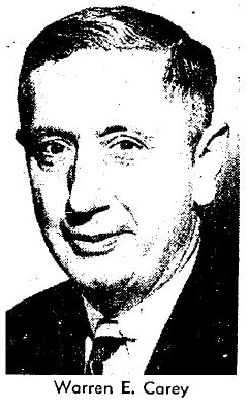 Fund allocations for the commission now stand at $108,750, but probably will be reduced somewhat, for the allowance was set up for nine months whereas there are but six and a half months remaining in the fiscal year.
Fund allocations for the commission now stand at $108,750, but probably will be reduced somewhat, for the allowance was set up for nine months whereas there are but six and a half months remaining in the fiscal year.
The commission, headed by Dr. Fred D. Fagg Jr., president of the University of Southern California, will no doubt work toward the formulation of an aviation code for the State, with power to adopt all present and future regulations of the (Federal) Civil Aeronautics Administration, he declared.
All peace officers will be empowered to enforce commission regulations under the new California Aeronautics Act, Carey said, adding the five members undoubtedly will advise the Legislature on proposed aviation legislation.
Long in Industry
Long a figure in California aviation, Carey was a pilot and head of aviation sales for an oil company from 1928 to 1938 when he beacme chief of the safety bureau, Civil Aeronautics Board, at Santa Monica directing accident investigation in California, Arizona, New Mexico and Utah.
During World War II he rose from captain to colonel in A.A.F. flying safety work at Washington and following his military service undertook the formulation of a master airport plan for California.
From the 8 Jan 1948 Times:
CITY C. OF C. ENTERTAINS STATE AVIATION AIDES
Members of the California Aviation Commission and its director, Warren E. Carey, yesterday were guests of the Los Angeles Chamber of Commerce aviation committee for an informal luncheon discussion of the aims of the new State agency.
[illegible] president of the University of Southern California and chairman of the commission; Norman Larson of Burbank, secretary, and Carey spoke. Dr. Fagg, a World War I pilot, said the group "has no preconceived notions except to promote aviation in California with a minimum of regulatory measures." He invited suggestions from the industry.
Carey, an Air Force officer in both wars, suggested investigation of zoning ordinances, local enforcement of air traffic regulations, furtherance of airway marking and mapping programs for private pilots and air cargo research as subjects for the commission to explore.
The committee adopted a resolution recommending a Statewide aviation conference in cooperation with the Bay area aviation committee to be held here March 18 and 19. Such meetings have been sponsored annually since 1943. Oscar Trippet, retiring vice-chairman of the chamber committee, presided.
The Los Angeles Daily News also reported on Col. Carey's appearance at the Chamber of Commerce luncheon. Their photographer even snapped a photo of Warren, caught in the act of eating:
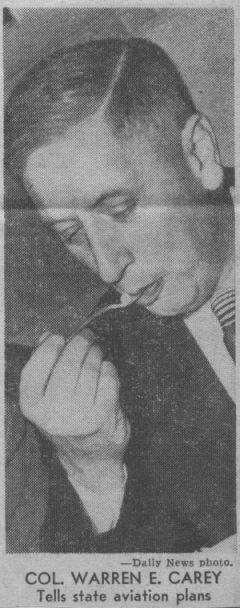
Revision to aid enforcement of state flying laws urged
Adoption by the state of aviation laws paralleling Federal civil air regulations is necessary to enforce air safety in California.
This view was expressed today as a major aim of the new State Aeronautics Commission by its director, Col. Warren E. Carey, at a oLs [sic] Angeles Chamber of Commerse [sic] luncheon.
"In the past, county officials have been unable to curb reckless pilots due to lack of uniformity in air laws on the state level," said Colonel Carey.
The director also indicated his commission would urge application of franchise taxes to support the commission's work.
While admitting the commission has not as evolved a complete and comprehensive policy since its inception, he outlined other problems which will be attacked by the five-man board.
These included:
- Helping airport operators fight abatement ptoceedings which threaten to close small fields close to thickly populated areas.
- Backing of an air marking program to include all California communities and thus aid private pilots who may wander from established airways.
- Compilation of a complete record of all aeronautical facilities within the state for private pilots.
- Expansion of the air-cargo industry to expand shipment by air of California perishables to Eastern markets.
- Liaison work with state educational faci1ities to develop new air-cargo packaging and handling techniques.
- Establishment of a Los Angeles branch of the commission to be located "on an airport."
A 16 Jun 1948 article reports that Warren served as a pallbearer at the funeral service for Frank Clark, "veteran motion picture stunt pilot", who had died in a crash, and mentions his membership in the "Aviators Post, American Legion".
A 13 Aug 1948 Times article quoted Warren as saying that California led all other states in aircraft registration, with a total of more than 10,000 civilian aircraft currently registered, or 10 aircraft registered per 10,000 population, with 18 per 10,000 estimated by 1950. On the 19th, Warren informed the Times that air mail revenue from Los Angeles and San Francisco alone accounted for some 24 per cent of the nation's total air mail business. A 19 Oct 1948 article quoted Warren's views at some length:
NEED OF AIR INDUSTRY FOR CUSTOMERS TOLD
"Aviation is still at the first page of its history," Warren E. Carey, director of aeronautics for the 11-month-old California Aeronautics Commission, told the Hollywood Advertising Club yesterday.
But the veteran of 5100 hours in the air warned that aviation also is confronted with an imperative selling job.
Carey said the aviation industry needs customers and highlighted this by pointing out that last year only 5% of the nation's population used the airlines and that only 20% has ever been aloft.
More business volume, he said, will result in lower costs to the public and to business. Carey added that such development need not be at the cost of present transportation mediums, but could be developed in new industries and markets.
He also told the club that the public must be sold on the advantages of a personal airplane -- that the navigable air ocean is available to everyone.
Carey then pointed out that the need for airports is crucial. He said that subdivisions, short-term leases, and high taxes have threatened private airports, particularly in Los Angeles County, with extinction. Had facilities been available, he said, 1500 more private planes could have been sold this year in this county.
Carey was the guest speaker for the club's first annual Air Transportation Day luncheon, attended by several hundred.
Four days later, Warren was listed among the guests on hand for the dedication of Riverside county's airport system at Ryan Field in Hemet.
From the 6 Mar 1949 Marvin Miles Skyways column:
Warren Carey, State director of aeronautics, has appointed a co-ordinating committee on the agricultural use of aircraft, in co-operation with A. A. Brock, director of agriculture.
The committee will discuss the many problems of the field with crop dusters and seeders, chemical manufacturers, farmers, College of Agriculture and the Aeronautics Commission.
Among subjects to be considered will be the demands for restrictive or regulatory legislation which certain faulty practices have prompted, Carey said.
From Miles' 1 May 1949 column:
A conference on the development and improvement of private flying has been scheduled by the Civil Aeronautics Commission for Fresno, May 21. Warren E. Carey, State Director of Aeronautics, says objectives of the conference will be: Developing ways and means of improving and promoting personal flying in California, discussion and analysis of pending and desirable State aviation legislation, and consideration of forming a permanent Statewide organization open to all private flyers.
Miles reported in his 4 Jun 50 column:
Warren Carey, State Director of Aeronautics, has been kind enough to send us one of the first copies of the new Air Navigation Chart of California. The California Aeronautics Commission has had this chart and airport directory in preparation for several months and hopes that funds from its sale will create a revolving fund for future revisions.
"We believe that it will be a distinct advantage to be able to fly anywhere in California with only one chart which accurately locates and describes 549 landing facilities many of which have not appeared on previous maps," Carey says...
The 3 July 1950 Times reported:
Airport Sites Action Delayed
Adoption of regulations to govern approval of new airport sites and issuance of airport permits has been postponed until after Sept. 1, it was announced yesterday by the California Aeronautics Commision.
Warren E. Carey, State director of aeronautics, explained the postponement is "to provide opportunity for consultation with all interested groups regarding the scope of the regulations."
Improved airports in existence on June 30 last year, he said, must be granted airport permits without regard to minimum requirements which may be established by the regulations.
An article from the 23 Aug 1950 Los Angeles Times quoted Warren as putting forth what must have sounded very radical at the time:
Ownership by State of All Airports Urged
SACRAMENTO, Aug. 22 (U.P.)-- The State Aeronautics Commission called today for ultimate public ownership of all airports in California.
It recommended expenditure of $14,630,000 in public funds during the next five years to "round out" a State airport system.
"We believe that the development of a system of airports to serve the needs of the air transport industry and the individual aircraft owner is as much a function of government as the provision of suitable highways and water transportation facilities," Warren E. Carey, State Director of Aeronautics, said in releasing the report.
"Only through ultimate public ownership can the permanence of such a system be assured," he added.
The five-year rounding out program recommended by the commission would include construction of 123 new airports, improvement of 62 already publicly owned, and "integration of 93 privately owned fields.
The program does not include additions and improvements already programmed for this year by the Federal government.
In the 26 Aug 1950 Los Angeles Times:
Twenty-eight New Airports Proposed
Aeronautics Board Plan Would Give County 54 Fields by 1955
Los Angeles County will have 28 new airports by 1955 if recommendations of the California Aeronautics Commission are carried out.
Since last December commission experts have been drawing up a revised State Airport Study, with recommendations for rounding out the State airport system within five years. Details were learned by The Times yesterday.
State Director of Aeronautics Warren E. Carey emphasized however, that the plan does not envisage State ownership of the system.
Program Explained
"Rather it's a plan for the orderly development of an adequate and permanent system of airports to meet the needs of the aviation industry which is daily becoming more important to the economic life of the State," he declared.
Suggested sponsors, in most cases, are local elements of government--city or county--with nine recommendations for joint county and state sponsorship and only two for State sponsorship alone--Castaic and Gorman--because of predicted wide general use on the Los Angeles-San Francisco Airway.
Addition of the recommended 28 new fields would bring the county airport total to 54 by 1955, the report shows...
With the outbreak of the Korean War, national defense was once again being discussed, and a 19 Sep 1950 article reported on a meeting of "private pilots, airfield operators and flying groups" at Lockheed Air Terminal. Warren Carey was one of many aeronautics experts in attendance at the meeting.
A 21 Nov article reported a controversy between Warren and LAX manager Woody DeSilva:
Waste of Air Funds in State Charged
Allocation Plan Fails to Expand Facilities, Aviation Chief Says
Allocations of California aviation funds are being dissipated without substantial gain to the State, Warren Carey, State Director of Aeronautics, charged yesterday before the Assembly Interim Committee on Aviation.
The present method of airport development in California wherein cities or counties participate in an airport program at the whim of local political bodies will never produce a system of airports adequate to the needs of the State," Carey declared.
The Aironautics Director explained the source of revenue for the State-aid airport program is unclaimed refunds of the motor vehicle tax on aviation gasoline, totaling $250,000 to $300,000 annually.
No New Airports
It is now distributed to counties on the basis of population and area, and shared with airport-owning cities within the counties, he said.
"Amounts distributed to cities and counties have been used largely to offset capital expenditures already budgeted or to make minor improvements to existing airports," Carey continued. "So far as is known, no new airports have resulted from this form of State aid.
"An important further consideration is the fact that funds so dissipated are not matched with Federal airport funds as would be possible if expended on specific airport projects under proper State control. The amount available could be more than doubled in effectiveness in this manner."
Five Reasons Listed
Carey listed five reasons why the present distribution of funds is impractical:
- No state control over expenditures,
- allocation bears no relation to airport need,
- funds are contingent upon ownership rather than a desire to own,
- amounts are relatively insignificant individually,
- allocation is wholly unfair to some counties.
He recommended that the State airport funds be administered through a State agency "so State aid can be allocated where it is needed, so we can take advantage of matching Federal funds, so we can build a proper California airport system."
He emphasized that he did not advocate a State-owned airport system, but simply State aid to cities and counties which can not develop needed airport programs.
Disputed by DeSilva
Woodruff DeSilva, manager of Los Angeles International Airport, took issue with Carey at the State Building session presided over by Assemblyman Earl W. Stanley, chairman of the Aviation Interim Committee.
DeSilva, representing the Department of Airports (which received $22,198 in State allocations during the last year -- by far the largest amount in California) contended administration at the city and county level can be just as efficient as State administration. He pointed out, too, that Los Angeles has received Federal airport funds...
The following is a quote from Marvin Miles' Skyways column in the 26 Aug 1951 issue of the Times:
Sorry to hear that Warren Carey is resigning as State Director of Aeronautics. We've known Warren a long time and he's a good man. Norm
Larson, chairman of the California Aeronautics Commission, asks the assistance of all aviation industry groups in locating a man who will be qualified to fill Warren's post when it becomes vacant next Nov. 1. Suggestions should go to Earl Pruden, commission secretary, in care of Ryan Aeronautical Corp., San Diego.
A 17 Sep 1951 article reported on the search for a replacement for Warren by aeronautics commission directors. There were no less than 23 applications for his position.
After Warren's departure from public office, there were only a few mentions of him in the press, but obviously he stayed interested in aviation the rest of his life.
A 9 Sep 1956 Skyways column related an informal get-together at the Hollywood Roosevelt Hotel of "sky heroes of yore, who flew by the seat of their pants and came up with performances that caught the public's fancy in the years before electronics and jets and supersonic speed". Warren was just one of many "old-timers" who came to relive the "golden days of high adventure, the storms, the crack-ups, the dangers and the fun of an era when hot little civilian planes frequently outperformed the military to sell aviation to America in vivid, bombastic terms."
In a 12 May 1957 Skyways, Warren was mentioned as the treasurer of the California Wing OX-5 Club of America, a "pioneering airman organization", which was about to have its San Diego Take-off Dinner at the U.S. Grant Hotel there. He was mentioned again 16 Jun 1957 when the same organization was planning a meeting at Ontario International Airport which would feature a History of Flight show.
The following articles appeared in the Times following Warren's passing in August 1963:
W. E. Carey, Flight Expert, Dies at 67
Warren E. Carey, first director of the State Aeronautics Commission and a veteran pilot, died Tuesday of an apparent heart attack.
The 67-year-old aviation expert collapsed at his home at 2042 Micheltorena St. at breakfast and died before help could be summoned.
He was appointed director of the Aeronautics Commission Dec. 9, 1947, shortly after it was established and served in that capacity until Nov. 1, 1951.
Carey, well-known among aviation pioneers, logged 5,100 hours in the air by 1947.
During the 1920s he was head of Union Oil Company's aviation division and later served as the senior accident investigator for the Civil Aeronautics 8oard here before entering the Air Force in World War II. He was discharged as a colonel.
In recent years Carey was in business. He was in the process of selling his grocery market to retire at the time of his death.
Masonic services will be conducted at 12:30 p.m. Friday at Pierce Bros. Mortuary in Hoilywood. Interment will be in Forest Lawn.
He leaves his wife, Wilma; a sister, Miss Ruth Carey, and a brother, George.
Ex-State Air Chief Warren Carey Rites Set
Masonic funeral services for Warren E. Carey, 67, 2042 Micheltorena St., will be held Friday at 12:30 p.m. at Pierce Brothers Mortuary, Hollywood, with interment in Forest Lawn.
Carey, flight expert and World War II Air Force colonel, was the first director of the State Aeronautics Commission and served in that capacity until 1951. He died Tuesday.
He leaves his widow, Wilma; a sister, Ruth, and a brother, George.
I remember that Warren's funeral service was well-attended not only by his Masonic brothers, but also by aviation pioneers, including members of the Ancient and Secret Order of Quiet Birdmen. Warren's passing was also recorded in the 24 August issue of the Urbana Daily Citizen, even though he had been away from Urbana more than 40 years:
Warren E. Carey
Warren E. Carey, 67, a native of Urbana and cousin to Kenneth Carey, pastor of the Urbana Friends Church, died Tuesday morning in Los Angeles, California.
Born January 29, 1896, the oldest son of George E. and Melissa Waldron Carey, he left Urbana with his minister father and lived in New Moorefield, Springfield and Troy before moving to Los Angeles in 1920.
Carey was in both world wars and retired as an Air Force Reserve Colonel. He was active on the Civil Aviation Board in the federal government.
He is survived by his widow, Wilma Carey; a sister Ruth Carey and a brother George Carey Jr., all of Los Angeles and several cousins in this area.
1 This agency still exists, as a part of the California Department of Transportation. According to its
web page:
The California Department of Transportation's mission in aviation is to foster and promote the development of a safe, efficient, dependable, and environmentally compatible air transportation system. The State's aviation commitment began in 1947 with the California Aeronautics Commission which eventually became the Division of Aeronautics in Caltrans...
This page was last updated 2 Jun 2016.



 The picture of W. E. Carey on the left appeared in a 7 Apr 1935 article which described in detail a new Stinson Reliant cabin monoplane acquired by Union. (See photo of aircraft below.) The article concluded:
The picture of W. E. Carey on the left appeared in a 7 Apr 1935 article which described in detail a new Stinson Reliant cabin monoplane acquired by Union. (See photo of aircraft below.) The article concluded:


 Fund allocations for the commission now stand at $108,750, but probably will be reduced somewhat, for the allowance was set up for nine months whereas there are but six and a half months remaining in the fiscal year.
Fund allocations for the commission now stand at $108,750, but probably will be reduced somewhat, for the allowance was set up for nine months whereas there are but six and a half months remaining in the fiscal year.
